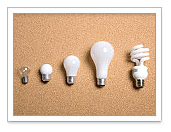
|
 |
Brian Berman President / Sr. Loan Specialist Mortgage Atlanta, LLC Phone: 678.564.1522 Fax: 888.727.0145 License: NMLS Company License # 184273 bberman@Mortgage-Atlanta.com www.mortgage-atlanta.com |
 | ||
| ||||
February 2012

|
New Rules for Light Bulbs Mean Lower Electric Bills As federal energy provisions kick in, it means the end for inefficient light bulbs. By Pat Mertz Esswein, Kiplinger.com
Chalk it up to progress, pollution control and energy security. In January, as more provisions of the Energy Independence and Security Act of 2007 kick in, Thomas Edison's brilliant invention, the incandescent light bulb, had to shape up or ship out. The old-style bulb is targeted for obsolescence because it converts just 10% of the electricity it uses into light and radiates the rest as heat. Under the law, incandescents are not banned, nor are compact fluorescent (CFL) bulbs mandated as replacements. Manufacturers and wholesalers do have to meet new standards that are forcing them to improve the efficiency of incandescent bulbs or replace them with newer technologies. The law phases in over the next two years, and the 100-watt bulb is the first victim. (California implemented the law a year ago.) The Department of Energy says that the average household that replaces 15 traditional incandescent bulbs will save $50 annually on its energy bill – and the newer bulbs last longer. You have three main alternatives: Halogen incandescents ($4 to $8 per bulb) offer energy savings of 25% and an expected life of up to three times longer than traditional incandescents – plus a brightness level and light color comparable to that of traditional bulbs. Annual savings if you replace 15 60-watt incandescent bulbs: $19.50. CFLs ($1.75 to $2, even after a spike in CFL prices after China restricted the supply of rare earth metals used in the bulbs) offer energy savings of 75% and last ten times longer than old-fashioned bulbs. Annual savings: $54. Light-emitting diodes, or LEDs ($10 to $26), provide an average energy savings of 75% to 80% and last up to 25 times longer. Annual savings: $57. LEDs are pricey, but costs will drop as more products come to market. Reprinted with permission. All Contents ©2012 The Kiplinger Washington Editors. www.kiplinger.com. | ||||||||||||||||||||||||||||||
Georgia Residential Mortgage Licensee #24081; NMLSR Company ID# 184273; NMLSR Loan Officer ID # 184320. Mortgage Atlanta, LLC 601 Woodlawn Dr, Suite 340 Marietta GA 30067. Rate subject to change. Borrower must meet all lender, state, federal requirements. Each office is separately owned and operated. You are receiving a complimentary subscription to YOU Magazine as a result of your ongoing business relationship with Brian Berman. While beneficial to a wide audience, this information is also commercial in nature and it may contain advertising materials. INVITE A FRIEND to receive YOU Magazine. Please feel free to invite your friends and colleagues to subscribe. SUBSCRIBE to YOU Magazine. If you received this message from a friend, you can subscribe online. UNSUBSCRIBE: If you would like to stop receiving emails from Brian Berman, you can easily unsubscribe. Mortgage Atlanta, LLC |
601 Woodlawn Dr, Suite 340 Marietta, Georgia 30067 Powered by Platinum Marketing © Copyright 2024. Vantage Production, LLC. | |||||||||


